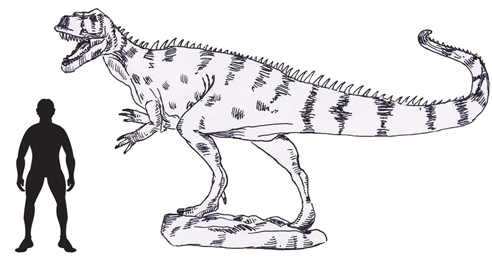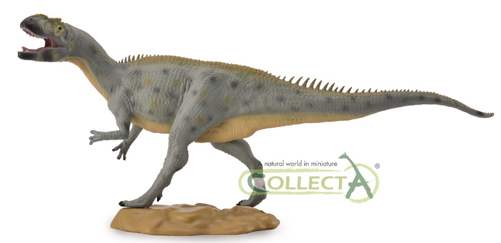Oxfordian Britain – The Kingdom of Metriacanthosaurus parkeri
Our thanks once again to young Thomas who has spent part of his summer holiday compiling blog articles for Everything Dinosaur. In this, his second piece, he focuses on the theropod fauna of the Late Jurassic of the British Isles and in particular a dinosaur known as Metriacanthosaurus parkeri, fossils of which come from Dorset.
Metriacanthosaurus parkeri
The Oxfordian in the UK is a rather mysterious faunal stage of the Late Jurassic, especially when it comes to what was living on land at the time. There are four described dinosaurs from this time one of which lived later in the Oxfordian than the others. These three are the metriacanthosaurid Metriacanthosaurus parkeri at 7.5 metres long and just over 2 metres tall, the megalosaurid Eustreptospondylus oxoniensis which had a juvenile length of 5 metres and hypothesised adult length of 6 metres and the ankylosaurian Priodontognathus phillipsii which was probably, only a few metres long, maybe 2 to 3 metres long.
Indeterminate Dinosaur Fossil Remains
Strata associated with the Oxfordian faunal stage, (early Late Jurassic), yields fragmentary, indeterminate dinosaur remains including an indeterminate sauropod found nearby to Metriacanthosaurus, a femur of a juvenile stegosaur and a large tooth from North Yorkshire belonging to a theropod, possibly metriacanthosaurid in nature. In addition, footprints have been found indicating other types of dinosaur present and based on fossil discoveries associated with strata from geologically older and slightly younger rocks than those ascribed to the Oxfordian, it can be concluded that megalosaurine megalosaurids, tyrannosauroids and ornithopods would have lived in the Oxfordian too, we just haven’t found them yet.
A Scale Drawing of Metriacanthosaurus parkeri
Picture credit: Everything Dinosaur
The British Isles During the Late Jurassic
The ecology of the time is also mysterious. We know for certain that the UK was separated into a series of islands, many of the islands were close enough to allow dinosaurs like Metriacanthosaurus and Eustreptospondylus to travel between them. However to reconstruct the flora and habitat we can look back to the Callovian stage as its likely the environment wasn’t too different from then which allows for the conclusion to be drawn that the islands were semi-tropical and lush in plant life with forests located in the middle of the islands spreading outwards and ending near or in some places at the coast.
Mixed in with the forests would have been rivers, streams, small lakes, swamps, floodplains, open woodland areas closer to the coast and at the coast, estuaries, marshes, ooid beaches, bars, lagoons, coves and other coastal structures.
A Seasonal Climate
The dry season on the islands would have been long and dry with humid areas and during the wet season, the islands would have had to endure harsh tropical storms with hurricane force winds. Plant life consisted of pollen and spore releasing plants, gymnosperms like ginkgoes, conifers and cycads, ferns, other pteridophytes along with other plants such as horsetails. The climate would have been warm and subtropical to tropical.
Ooid Beaches – An Explanation and Metricanthosaurus parkeri
For context, ooid beaches are where beaches are made of small, fine sand-like granules of calcium carbonate, the largest quarry in the UK (Ketton Quarry), has a portion of it that dates to just before the Oxfordian stage and might help unravel the mystery behind the Oxfordian of Britain.
Metriacanthosaurus was most likely the apex predator of the time, hunting anything from smaller theropods to perhaps the sauropod dinosaurs it coexisted with, it would have had powerful jaws with large sharp teeth and long powerful arms tipped with large hand claws for grasping prey. Metriacanthosaurus’s raised neural spinal ridge was probably used for extra back muscle attachment anchor points allowing the animal to be physically stronger than other similarly sized theropods of the time, although this assessment remains largely speculative.
Metriacanthosaurus means “moderately-spined lizard”.
The CollectA Prehistoric Life Metriacanthosaurus parkeri Dinosaur Model
“Parker’s moderately-spined lizard”. This dinosaur was named after its tall neural spines.
The image (above) shows a Metriacanthosaurus model from the CollectA Age of Dinosaurs model series.
To view this range of prehistoric animal figures: CollectA Age of Dinosaurs Model Range.
A Unique Megalosaur
Eustreptospondylus is a rather unique megalosaur, it may have been a lot like today’s Komodo dragon frequenting many islands combing beaches, hunting down smaller animals, perhaps raiding nests of larger dinosaurs and possibly even hunting fish. Despite Eustreptospondylus’s hypothesised adult size, it would have still been prey for the likes of Metriacanthosaurus. A specimen of another dinosaur found from this geological time is an ankylosaur called Priodontognathus. It was around 2 to 3 metres long and is known from Yorkshire.
Our thanks once again to Thomas for sending in his article to us.
To read the first article submitted by Thomas: The “Scunthorpe Pliosaur.”
To request further information about Everything Dinosaur’s blog posts: Contact Us By Email.








Leave A Comment